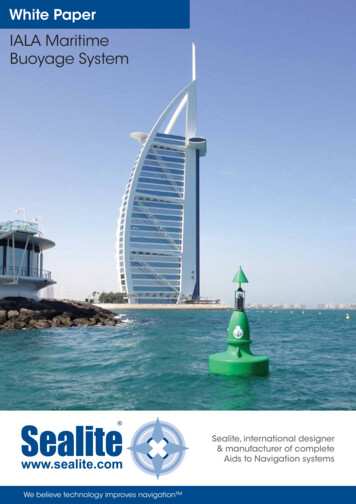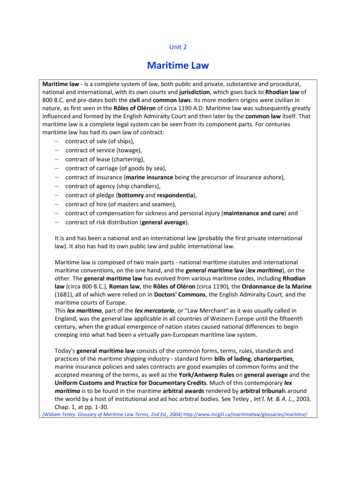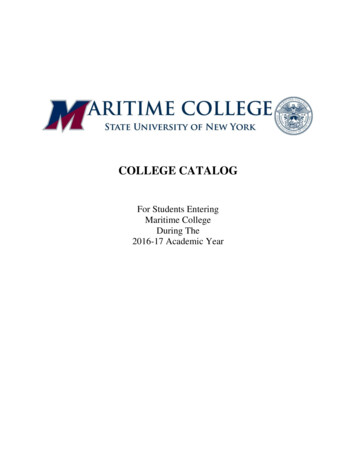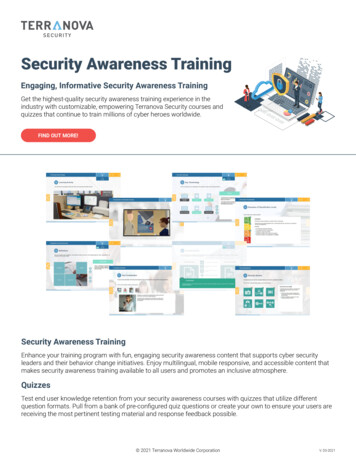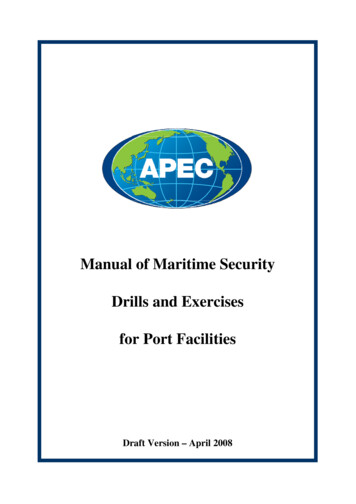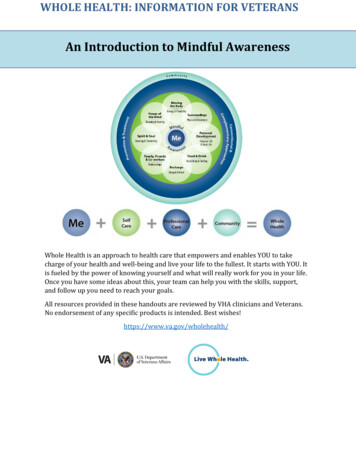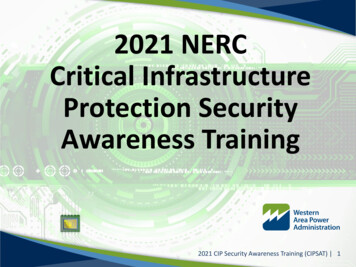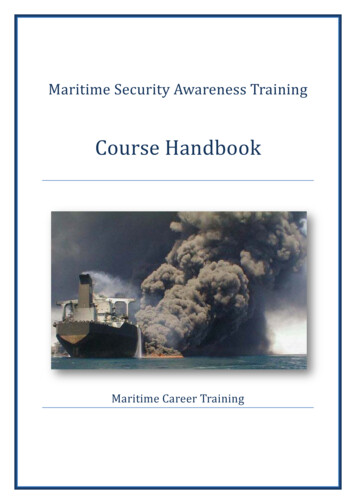
Transcription
Maritime Security Awareness TrainingCourse HandbookMaritime Career Training
Maritime Security Awareness TrainingCourse HandbookPrinted in Queensland,Copyright 2012 Maritime Career Training
Table of ContentsChapter 1: Introduction1.1 The importance of maritime security . 1-11.2 Timeline of events shaping the maritime security environment - an Australian context. 1-21.3 Maritime security awareness course objectives and overview. 1-31.4 Assessment and Certification . 1-3Interesting Maritime Security Case studies1.5 MV Limburg Bombing 2002 . 1-41.6 USS Coal Bombing 2000 . 1-51.7 Boarding and Hijacking of the Maersk Alabamba, 2009 . 1-61.8 The Hijacking of the Cruise Liner Achille Lauro, 1985. 1-71.9 Terrorist attack on Super Ferry 14 in 2004. 1-8Chapter 2: Maritime Security threats and threat recognition2.0 Threats to Maritime security . 2-22.1 Maritime terrorism2.2 Piracy.2-2.2-42.3 Organised Crime.2-102.4 Other Security Threats .2-112.5 Identification of potential security threats . 2-14Chapter 3: Maritime Security Threats and Definitions3.1 Introduction to maritime security terms and definitions . 3-33.2 Terms and definitions relating to legislation and Maritime Security Agencies. 3-33.3 Terms relating to the ISPS code and Maritime Transport Offshore Facilities Security Act . 3-53.3.1 Terms, definitions and acronyms relating to Security Personnel3.3.2 Terms relating to ports and ships.3-5.3-53.3.3 Terms relating to assessments, plans, audits and certification.3-63.3.4 Terms and definitions relating to security levels .3-73.3.5 Terms and definitions relating to maritime security zones .3-83.6 Abbreviations used in this course . 3-9Chapter 4: International and National Maritime Security Policy andResponsibilities4.1 International and National Maritime Security Policy Overview. 4-24.2 ISPS Code. 4-3
4.2.1 Overview .4-34.2.2 ISPS Code Objectives and Functional Requirements4.2.3 ISPS Code Application.4-3.4-44.2.4 ISPS Code Contents .4-44.2.5 ISPS Code Key Concepts.4-54.2.6 ISPS Code Responsibilities.4-134.3 Australian Maritime Transport and Offshore Facilities Security (MTOFS) Act 2002 . 4-154.3.1 Overview .4-154.3.2 Purpose and Maritime Security Outcomes.4-154.3.3 Contents .4-154.3.4 Act Application.4-164.3.5 Act Key Concepts.4-184.3.6 Security Plans.4-204.3.7 Maritime security zones.4-124.3.8 Maritime Security Identification Card (MISC) .4-234.3.9 MTOSF Security Personnel .4-24Chapter 5 – Maritime Security Levels5.1 Maritime Security Levels – Overview. 5-25.1.2 Application .5-25.1.3 Responsibilities.5-35.2 How security levels are set and communicated in Australia. 5-55.3 Security Directions . 5-75.4 Impact of maritime security levels on ship’s security measures . 5-8Chapter 6 – Contingency Planning6.1 Overview . 6-26.2 Security risk assessment. 6-46.3 Security plans. 6-66.4 Security Controls. 6-96.5 Piracy contingency planning and security controls. 6-11Chapter 7 – Techniques to Circumvent Maritime Security Measures7.0 Overview . 7-27.1 Common measures used to circumvent port and vessel security . 7-27.2 Techniques to circumvent cargo security measures. 7-77.3 Techniques used to circumvent searches for illegal items. 7-97.4 Corruption of port security/ ship personnel . 7-11
Chapter 8 – Recognition of weapons, dangerous substances8.1 Overview . 8-28.2 Weapons used in terrorist attacks . 8-28.3 Weapons of mass destruction . 8-78.4 Weapons used in Piracy . 8-9Chapter 9 – Handling security-related information and comms9.1 Overview . 9-29.2 Responsibilities communicating security-related information. 9-29.3 Security Plans. 9-29.4 Handling security-related information. 9-39.5 Maritime security information – key sources .9-4Chapter 10 – Security Reporting Procedures10.1 Introduction . 10-210.2 The difference between security incidents and security events . 10-210.3 Persons responsible for reporting maritime security incidents and events. 10-310.4 Record keeping on Regulated Australian Ships . 10-310.5 Reporting of maritime security incidents and events . 10-410.6 Handy References . 10-910.7 Event grade examples . 10-9Chapter 11- Maritime Security Training, Drills and Exercises11.1 Training of key security personnel and other personnel on ships and in ports. . 11-211.2 Drills and Exercises. 11-6
CHAPTER 1: Introduction1.1 The importance of maritime security . 11.2 Timeline of events shaping the current maritime security environment - an Australian context . 21.3 Maritime security awareness course objectives and overview. 31.4 Assessment and Certification . 3Interesting Maritime Security Case studies1.5 MV Limburg Bombing 2002 . 41.6 USS Coal Bombing 2000 . 51.7 Boarding and Hijacking of the Maersk Alabamba, 2009 . 61.8 The Hijacking of the Cruise Liner Achille Lauro, 1985 . 71.9 Terrorist attack on Super Ferry 14 in 2004 . 81.1 The importance of maritime securityThe concept of maritime security has changed significantly over the last 30 years. The world’soceans and water ways are very difficult to control from a security perspective. This is because vaststretches of international waters are not under the control of any particular nation and waterwaysthat are controlled by different countries are often poorly monitored. As a consequence, ouroceans and water ways have proved to be an ideal environment for transnational crimes such aspiracy and terrorism.The shipping industry carries more than 90% of the world’s trade and in Australia that figure rises to99%. The events of September 11 highlighted the vulnerability of the world’s transport system toattack and triggered international action that resulted in many new codes, laws and proceduresbeing designed to enhance maritime security.It is important that all participants in the maritime industry understand the basic concepts ofmaritime security so each individual can contribute to the security of their ship, port facility or offshore facility. Today, the implications of maritime security impact on the daily work environment ofmost mariners in any area of the maritime industry. For example this can include: transiting througha secure port facility to join a ship; understanding the security requirements when joining a ship; orparticipating in ship security exercises when onboard a ship. Anyone can come face to face with asecurity threat at any time and by being able to correctly recognise and respond to the threat theymight stop a serious situation from developing.Maritime Career TrainingSecurity Awareness Training1-1
The IMO recognised the importance of Maritime Security Training by making it a requirement forMaritime Security Awareness Training to be a compulsory element in the Certificate of SafetyTraining 2014.1.2 Timeline of events shaping the current maritime securityenvironment - an Australian contextMaritime security issues first appeared on the radar in 1985 following the hijacking of the Italiancruise ship Achille Lauro. The IMO (the United Nations Agency involved with safety of shipping andprotection of the marine environment) adopted a resolution to prevent unlawful acts whichthreaten the safety of ships and the security of their passengers and crews. In 1988 the Conventionfor the Suppression of Unlawful Acts against the Safety of Maritime Navigation was adopted. Piracyhas plagued the world’s waters for centuries and was recognised as a significant issue in 2000 when469 actual and attempted attacks were recorded. In 2000 the USS Cole was attacked introducing anew form of maritime terrorism when a small craft laden with explosives crashed into her hull whileshe was alongside in port. In 2002 the MV Limburg was attacked in a similar manner which left littledoubt that Al –Qaeda had developed the capability to carry out attacks in the maritime domain.The single biggest event that saw a shift in global thinking towards security was the September 11attack on America in 2001. This changed global attitudes towards security and led to thedevelopment of many new laws, codes and conventions to enhance maritime security by increasingthe level of security of a specific location or vessel and by identifying key areas of the maritimeindustry that were weak and could be exploited by criminals.Possibly the most significant development in maritime security legislation was the introduction ofthe International Ship and Port Facility Security (ISPS) code by the International MaritimeOrganisation (IMO) in 2002. This code included several amendments to the 1974 Safety of Life atSea (SOLAS) convention. It was the fastest ever convention to be adopted in the IMO. The aim is toprovide a standardised, consistent framework for assessing and applying security measures by allcountries who have signed the SOLAS convention. The code requires Governments to undertake riskassessments in order to establish the level of security threat in their ports. It also requires that shipsand ports appoint dedicated security officers who oversee formal security plans that are approvedby their Governments. The ISPS code has had wide-ranging implications for governments, shippingcompanies and port facilities. Much of this security awareness course will be based on and directlyrefers to the Code.In Australia, the Maritime Transport and Offshore Facilities Security Act (MTOFSA or ‘the Act’) wasdeveloped as the key piece of legislation to implement the ISPS code. The Act provides a regulatoryframework that assists the development and implementation of maritime security plans for ships,ports and offshore facilities. It is the Act which details the security requirements to be employed byAustralian registered vessels and not the ISPS code. Having said this, compliance with The Act willnaturally imply compliance with the ISPS code.Maritime Career TrainingSecurity Awareness Training1-2
The Office of Transport Security (OTS) was established as an agency of the Australian Department ofInfrastructure and Transport. The purpose of the OTS is to regulate transport security and advisethe federal government on transport security matters. Its direct focus is the development ofeffective security policy and planning. The OTS has no capability to respond to a security incident asthis responsibility is given to the Police, customs or relevant response agencies in each state andterritory. The head of the OTS is the First Assistant Secretary (the Secretary).1.3 Maritime security awareness course objectives and overviewThis course aims to give you the following proficiencies as identified in IMO table A-V1 61 (2) Basic working knowledge of maritime security terms and definitions, including elements thatmay relate to piracy and armed robberyBasic knowledge of international maritime security policy and responsibilities ofGovernments, companies and personsBasic knowledge of maritime security levels and their impact on security measures andprocedures aboard ship and in port facilitiesBasic knowledge of security reporting proceduresBasic knowledge of security-related contingency plansBasic knowledge of techniques used to circumvent security measuresBasic knowledge enabling recognition of potential security threats, including elements thatmay relate to piracy and armed robberyBasic knowledge enabling recognition of weapons, dangerous substances and devices andawareness of the damage they can causeBasic knowledge in handling security-related information and security-relatedcommunicationsBasic knowledge of training, drill and exercise requirements under relevant conventions,codes and IMO circulars, including those relevant for anti- piracy and anti-armed robberyIt has been structured into 10 chapters after the Introduction that directly reflects the proficiencieslisted above.1.4Assessment and CertificationMaritime Career Training's Security Awareness Course is conducted with the approval of theAustralian Maritime Safety Authority. We will provide a Statement of Attainment to successfulapplicants upon completion of the course.A final written assessment will be conducted. The pass mark will be 70% or higher. Multiple choicequestions will make up no more than 40% of the marks. The remainder of the assessment questionswill involve short written answers.Maritime Career TrainingSecurity Awareness Training1-3
Interesting maritime security casestudies1.5 MV Limburg Bombing 2002Name: MV Limburg, 157,000-ton crude oil tankerDate: Oct 6 2002Location: Arabian seaDescription of attack: The MV Limburg was carryingaround 39,700 barrels of crude oil from Iran to Malaysiaon 6 October 2002.While in the Gulf of Aden to pick up another load, an explosives-laden dinghy rammed the starboardside of the tanker.The explosives detonated on impact and the vessel caught fire, killing one crew member and injuring12 others. 90,000 barrels of oil leaked into the Gulf of Aden, the fire was put out and the vessel wastowed to Dubai. The damage caused was around 45 Million US.Organisation: Al QaedaRamifications: Extensive damage, environmental pollution, 1 dead, 4 injuredSignificance for global maritime security: The attack is significant because it marks AlQaeda's first successful strike against an oil target.Maritime Career TrainingSecurity Awareness Training1-4
1.6 USS Coal Bombing 2000Name: USS ColeDate: 12 Oct 2000Location: Aden Harbour, YemenDescription of attack: A 35-foot boat laden withthe explosives RDX and TNT with two bombers onboard rammed the USS Cole port amidships while itwas refuelling in Aden harbor, ripping a 32-foot by 36foot hole in the hull and causing extensive internaldamage.A U.S. Navy investigation found that the ship'sofficers and crew failed to take a number of securitymeasures that would have possibly prevented theattack. At the time, Yemen was rated at a "high"threat level, the fourth-highest of a five-level threatalert system.The vessel was moored at a refuelling platform whenthe attack occurred. The two suicide bombers wavedto some of the ship's crew who were topside, many ofwhom later said they assumed the approaching craftwas a garbage boat. Many of the crew were belowdecks for lunch.The damage from the blast took 18 months and 250 million to repair.Organisation: Al Qaeda and Islamic army of AdenRamifications: 17 dead, 47injured, significant damage to thevessel, 2 attacker deaths.Significance for globalmaritime security: First time asuicide boat laden with explosiveshad caused a maritime terrorincident.Maritime Career TrainingSecurity Awareness Training1-5
1.7 Boarding and Hijacking of the Maersk Alabamba,2009Name: MV Maersk AlabambaDate: April 2009Description of attack: Somali piracyreached such levels that in 2009 the USMaritime Administration recommendedships stay 600 nm out to sea. On 8 April2009, four Somali pirates boarded theMaersk Alabamba 240nm off the coast whenshe was enroute to Kenya. At the time theship was carrying 20 crew and 17,000 metrictons of cargo.During the boarding, the captain stayed onthe bridge with two other crew memberswhile the rest of the crew locked themselves in the engine room. The ship’s engineers were able tosink the pirate speed boat shortly after the boarding by continuously swinging the ship’s rudder.They then took control of the ship from within the engine room and with it the Pirate’s ability tocontrol the ship.The crew later used brute force to overpower the pirates and free a hostage. The frustrated piratesthen decided to depart the ship in a lifeboat taking the Captain, Richard Phillips with them forbargaining power. The USS Bainbridge and USS Halyburton responded to the situation and a 4 daystandoff developed that ended in US snipers taking out three of the pirates and capturing the 4th.The captain was recovered in good condition. The Maersk Alabama has been attacked anotherthree times since then. In Nov 2009 she warded off pirates with small arms fire and acousticweapons. In 2010 the security team onboard repelled a skiff with 5 pirates and in 2011 a skiff of 5pirates tried to hijack the vessel from astern but was repelled by the ship’s armed security team.Organisation: Somali PiratesRamifications: Nil crew injured, hostagereleased.Significance for global maritimesecurity: This event brought the issue ofSomali piracy to the world pressMaritime Career TrainingSecurity Awareness Training1-6
1.8 The Hijacking of the Cruise Liner Achille Lauro, 1985Name: MV Achille LauroDate: October 1985Description of the Attack: TheAchille Lauro was an Italian cruise linerthat was sailing off Egypt to Port Saidin October 1985. She was attacked byfour men representing the PalestineLiberation Front (PLF) who wereseeking revenge after the Israelibombings of the PLO headquarters inTunis. The hijackers demanded thevessel sail to Tartus in Syria anddemanded the release of 50 Palestinianswho were in Israeli prisons. On arrival at Tartus, the ship wasrefused permission to dock and the hijackers killed a disabledJewish-American passenger Leon Klinghoffer and ordered crewto throw his body overboard. The ship headed back towardsPort Said and after two days of negotiations the hijackersabandoned the liner in exchange for safe conduct aboard anEgyptian airliner. Then President Ronald Reagan ordered thattheir planebeinterceptedby F-14s and they were escorted to a naval airbase in Sicily where the hijackers were arrested.Organisation: Palestine Liberation Front (PLF)Ramifications: 1 passenger killedSignificance for Global MaritimeSecurity: This event was recognised as one ofthe first maritime terrorism events. Afterwardsthe IMO investigated the concept of maritimeterror and in March 1988 released theConvention on the Suppression of Unlawful actsagainst the Safety of Maritime Navigation.Maritime Career TrainingSecurity Awareness Training1-7
1.9 Terrorist attack on Super Ferry 14 in 2004Name: Super Ferry 14Date: February 2004Location: En route from Manila to Cagayande Oro City.Organisation: Abu SayyafDescription: 90 minutes into a passengerferry crossing in the Philippines a bombexploded, killing 116 passengers. Fivemonths after the incident, Redondo CainDellosa admitted to planting the bomb inthe boat and six members of Abu Sayyafwere charged with murder.Investigators believed that the shipwas targeted by Abu Sayyaf becausethe company that owned it refusedto pay protection money.Ramifications: 116 killed,numerous injured. Substantialdamage to the vessel and loss to thecompany involved.Significance to Global Maritime Security: This isnot only the worst terrorist attack in the Philippines, it isalso the most deadly maritime attack at sea.Maritime Career TrainingSecurity Awareness Training1-8
Chapter 2: Maritime security threatsand threat recognitionThreats to Maritime security . 22.1 Maritime terrorism . 22.1.1 Definition . 22.1.2 Australia’s terrorism threat . 22.1.3 Weapons used by terrorists . 32.1.4 Biological/ chemical attack . 32.2 Piracy . 42.2.1 Somali pirates . 62.2.3 West African pirates . 72.2.4 South East Asian Piracy. 72.2.5 Techniques used in piracy. 82.2.6 Recent Piracy Examples . 82.3 Organised Crime . 102.3.1 Drug smuggling . 102.3.2 Cargo theft . 112.4 Other Security Threats . 112.4.1 Stowaways . 112.4.5 Disaffected Individuals: . 122.4.6 Violent or Disruptive Protest . 132.5 Identification of potential security threats . 14Maritime Career TrainingSecurity Awareness Training2-1
Threats to Maritime security2.1 Maritime terrorismTerrorism has become a major concern since theSeptember 11 attacks and has presented enormoussecurity challenges for companies andGovernments around the globe. While terroristsmay target a small group of victims, the realintended audience is often much wider. Forexample, the terrorist attacks on twin towers sent amessage to America and the rest of the world.The attacks of 9/11 and the Bali bombings underlinethe general and increased threat of terrorism wenow face. The attacks on the USS Cole and MV Limburg over the past five years highlight thepossibilities and dangers that maritime terrorism present.The international maritime community has become increasingly concerned about the possibility ofterrorists: placing a terrorist device inside cargo bound for a particular destinationusing a vessel to import cargo necessary for the terrorist group to function orillegally smuggling members of a terrorist operation2.1.1 DefinitionTerrorism can be defined as:the use of violence and threats to intimidate or coerce, especially for political purposesTerrorism: involves the use of or violence against people or property to intimidate, coerce or todemand ransomis conducted by organised groupsis politically motivated and is aimed at raising political awareness or achieving politicalgoalsoften use threats to create public fear.2.1.2 Australia’s terrorism threatA terrorist attack on Australia’s maritime industry is definitely possible. Terrorists have stated adesire to create maximum economic impact and Australia relies heavily on shipping and seabornetrade. Australia is also adjacent to a region where terrorist groups have known maritimecapabilities.Maritime Career TrainingSecurity Awareness Traini
Maritime Security Awareness Training to be a compul sory element in the Certificate of Safety Training 2014. 1.2 Timeline of events shaping the current maritime security environment - an Australian context Maritime security issues first appeared on

